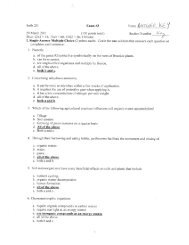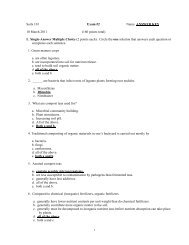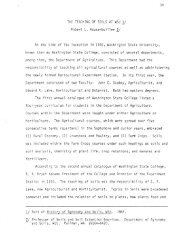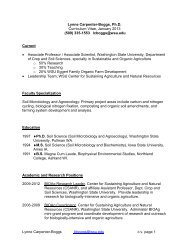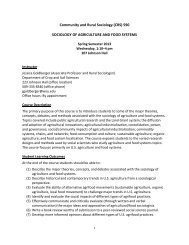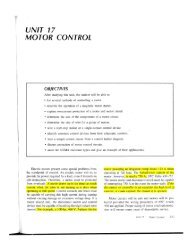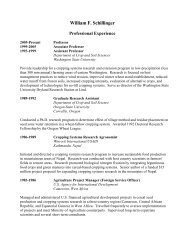2012 Dryland Field Day Abstracts - Dept. of Crop and Soil Sciences ...
2012 Dryland Field Day Abstracts - Dept. of Crop and Soil Sciences ...
2012 Dryland Field Day Abstracts - Dept. of Crop and Soil Sciences ...
You also want an ePaper? Increase the reach of your titles
YUMPU automatically turns print PDFs into web optimized ePapers that Google loves.
Page 34<br />
<strong>2012</strong> <strong>Field</strong> <strong>Day</strong> <strong>Abstracts</strong>: Highlights <strong>of</strong> Research Progress<br />
<strong>Soil</strong>borne wheat mosaic (SBWM) is a new problem for Washington wheat growers having been first recognized in 2008 in the Walla<br />
Walla area. This disease is caused by a virus that is transmitted by a fungal-like organism that lives in soil. Roots are infected in the<br />
fall <strong>and</strong> symptoms appear in early spring. Because the virus lives in soil, the disease occurs in the same spots within fields each year<br />
<strong>and</strong> can be moved with soil on farm implements, shoes, or tires. The problem appears limited to the Walla Walla area at the<br />
current time, but we have been collaborating with scientists from Oregon State University to screen PNW wheat varieties for<br />
resistance. A few varieties from the PNW have some resistance, with the hard red winter wheats having the best resistance as a<br />
class.<br />
Results <strong>of</strong> our field test data are available online at the WSU Variety testing website (http://variety.wsu.edu) <strong>and</strong> Plant Disease<br />
Management Reports (http://www.plantmanagementnetwork.org/pub/trial/PDMR/reports/<strong>2012</strong>). This research is part <strong>of</strong> our long<br />
-term goal to improve resistance <strong>of</strong> winter wheat varieties to these important diseases <strong>and</strong> thereby reduce yield losses for<br />
Washington State wheat growers.<br />
Molecular Diagnostics for Plant-Parasitic Nematodes in the Pacific Northwest<br />
Patricia Okubara 1 , Guiping Yan 2 <strong>and</strong> Richard Smiley 2<br />
1 USDA-ARS, Root Disease <strong>and</strong> Biological Control Research Unit, Pullman; 2 Columbia Basin Agricultural Research Center,<br />
OSU, Pendleton, OR<br />
Plant-parasitic nematodes affect the health <strong>and</strong> yields <strong>of</strong> wheat, barley <strong>and</strong> other crops <strong>of</strong> Pacific Northwest (PNW). The root-lesion<br />
nematodes Pratylenchus thornei <strong>and</strong> P. neglectus are estimated to cause $51 million losses to the wheat industry each year. <strong>Crop</strong>s<br />
used in rotation with wheat, including pea, chickpea, lentil, canola <strong>and</strong> mustard, are<br />
also susceptible to root-lesion nematodes. The cereal cyst nematodes Heterodera<br />
avenae <strong>and</strong> H. filipjevi pose additional threats to wheat <strong>and</strong> barley production,<br />
causing estimated annual losses <strong>of</strong> at least $3.4 million. We have developed rapid,<br />
sensitive <strong>and</strong> specific conventional <strong>and</strong> real-time PCR assays for P. thornei, P.<br />
neglectus, <strong>and</strong> H. filipjevi in PNW soils. Conventional PCR assays detect 60 <strong>and</strong> 150 P.<br />
thornei <strong>and</strong> P. neglectus juveniles per pound <strong>of</strong> soil, respectively, well below the<br />
calculated economic threshold <strong>of</strong> 1,000 juveniles per pound <strong>of</strong> soil. Our real-time<br />
PCR assay for P. thornei detects 450 juveniles per pound <strong>and</strong> correlates well (r 2 =0.76)<br />
to the conventional extraction <strong>and</strong> counting method. The molecular diagnostic<br />
assays circumvent time-consuming quantification <strong>and</strong> microscopic examination <strong>of</strong><br />
the nematodes, thereby facilitating surveys <strong>and</strong> management assessments. Realtime<br />
PCR assays for P. neglectus <strong>and</strong> H. avenae are being developed.<br />
Top: Guiping Yan conducting real-time<br />
PCR assays. Left: Micrographs <strong>of</strong> the<br />
nematodes<br />
Anomalous Armyworm Infestations in Eastern Washington <strong>and</strong> Oregon Wheat Implicate Dargida<br />
spp. plus other Noctuids<br />
Diana Roberts, WSU Extension, Spokane, WA; Peter L<strong>and</strong>olt, USDA-ARS, Yakima, WA; Mary Corp, OSU Extension, Pendleton,<br />
OR; <strong>and</strong> Silvia Rondon, OSU, Hermiston, OR<br />
Unusual, armyworm-type damage to wheat <strong>and</strong> barley crops in Lincoln County, WA, <strong>and</strong> Umatilla County, OR, in 2007 <strong>and</strong> 2008<br />
prompted concern <strong>and</strong> further investigation. Damage in each county was restricted to areas about 20 miles in diameter.<br />
Universal Moth Traps baited with an armyworm sex attractant (pheromone) were effective in trapping male moths. Traps located<br />
across the cereal-producing counties <strong>of</strong> eastern Washington in 2009 <strong>and</strong> 2010, <strong>and</strong> Umatilla County, OR, in 2010 <strong>and</strong> 2011,<br />
confirmed the presence <strong>of</strong> the original suspect, the wheat head armyworm Dargida diffusa (Walker). However, the native species<br />
Dargida terrapictalis (Buckett) was the predominant Noctuid moth captured.




